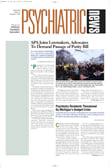In an effort to increase effectiveness and reduce dosing, side effects, and potential drug interactions, pharmacologists are isolating and purifying specific forms of psychiatric drugs.
Many chemical compounds, including several psychoactive medications, exist as mixtures, made up of slightly differing forms of the active chemical called isomers.
In recent years several pharmaceutical companies have undertaken the separation of those isomers in an effort to fine-tune the actions of a medication already on the market. The recent approval of dexmethylphenidate (Focalin) is simply the latest example of a successful attempt (
see story above).
Another company working on taking advantage of the separation of isomers is Forrest Pharmaceuticals, with its very successful SSRI citalopram (Celexa).
“Celexa is a 50-50 racemic mixture,” said Ivan Gergel, M.D., vice president of clinical development and medical affairs for Forrest. “Essentially all the same atoms are in the two molecules, but they are arranged slightly differently inasmuch as one is a mirror reflection of the other,” he told Psychiatric News.
It was apparent early on to pharmacologists working for Danish pharmaceutical firm H. Lundbeck AS, which developed citalopram for Forrest, that the compound was a racemic mixture, Gergel said. Early preclinical tests on separating the two forms of the drug, R-citalopram and S-citalopram, produced encouraging results that led the company to pursue separation of the two isomers as a clinical program.
Mirror image (or racemic) isomers are labeled as “right handed” (termed “R-” or dex- ) or “left handed” (termed “S-” or “levo-”).
The end result of Forrest’s work, a New Drug Application for S-citalopram under the generic name of escitalopram, was filed with the FDA last March. The company expects to have FDA approval in the near future, Gergel said.
It turns out that escitalopram is nearly four times more potent as an SSRI than the mixture present in the parent compound citalopram. In company-sponsored clinical trials, the drug not only appears to be more efficacious at lower doses (a 10 mg dose of escitalopram is roughly equivalent to 40 mg of citalopram) but also has better side-effect and drug-interaction profiles.
The two isomers of citalopram are “very different,” Gergel told Psychiatric News. “The R- isomer doesn’t have much effect on serotonin reuptake, but does, for example, have a large effect on histamine receptors leading to somnolence and sedation as a side effect.” In removing the R- isomer, pharmacologists were able to reduce that side effect.
In addition, most of citalopram’s interaction with the cytochrome P-450 metabolic system also involves the R- isomer, specifically a metabolite of the R- form. The S- isomer doesn’t interact with P-450, leading to fewer potential drug interactions with persons taking escitalopram. This, Gergel emphasized, is especially important for patients taking multiple medications, which is so common in the elderly—where citalopram is considered by the American Academy of Geriatrics guidelines to be a first-choice medication for depression. Gergel believes that escitalopram will be even better.
“At the end of the day, this is going to make a difference to a lot of patients’ lives, and that’s what it’s all about,” he told Psychiatric News.
He also cautioned that, in the separation of isomers, exactly what the end product will be is the big unknown. While escitalopram and dexmethylphenidate are striking success stories in isomer pharmacology, there have also been significant failures. Late last year, Eli Lilly and Company halted development of the R- isomer of fluoxetine (Prozac) after Stage III clinical trials revealed unexpected cardiac side effects (Psychiatric News, December 1, 2000). The company had hoped that R-fluoxetine would replace fluoxetine, which was facing imminent expiration of its patent protection.
“It’s an example of their doing it, and it turned out badly,” Gergel said. “We did it, and it has gone better than any of our expectations.” ▪
